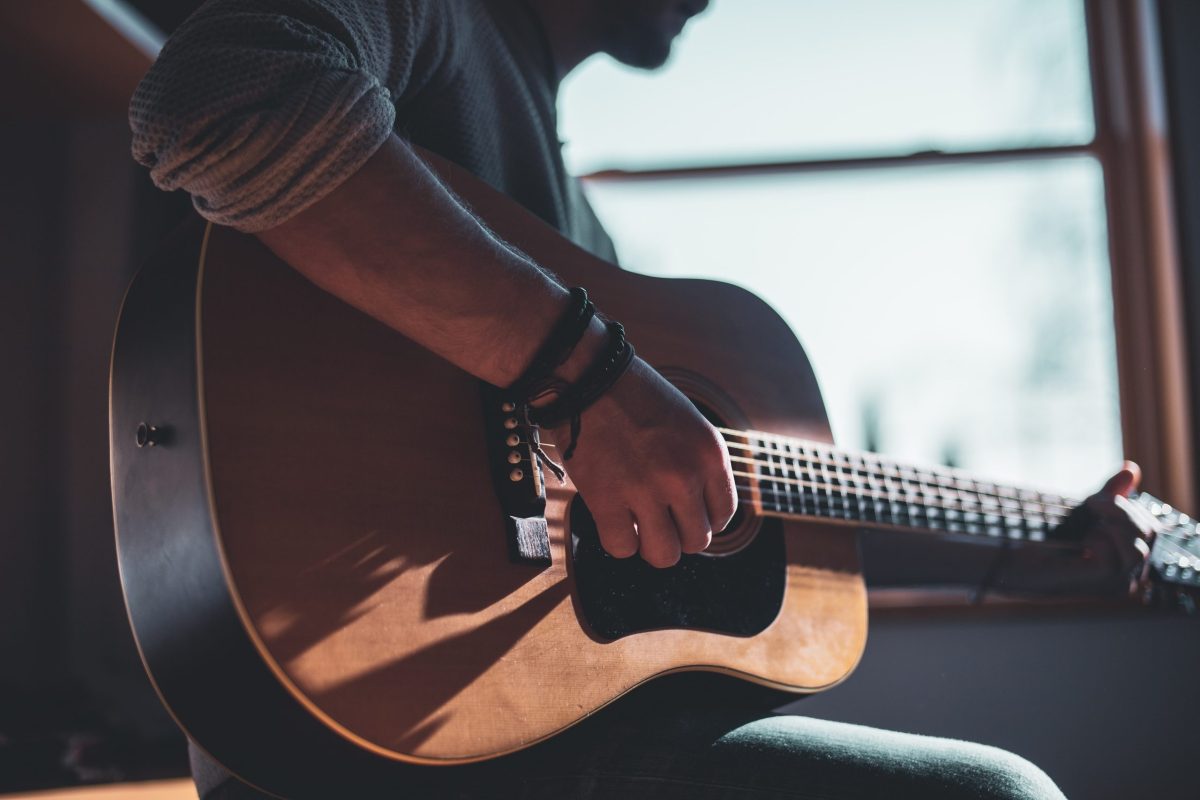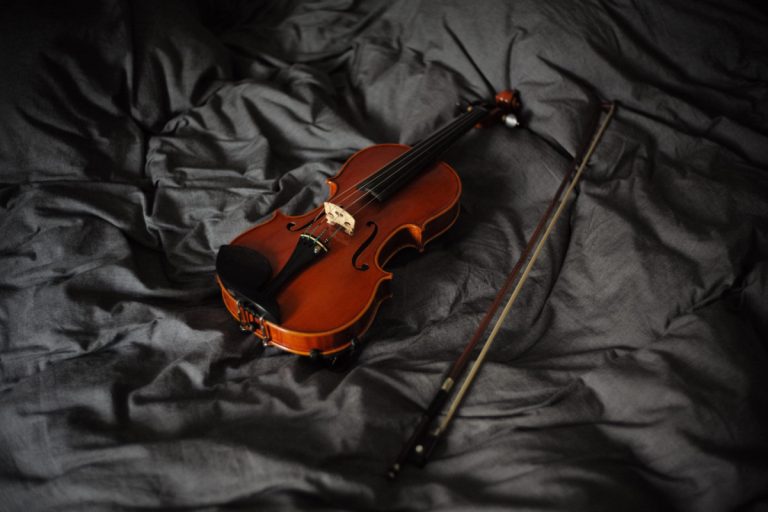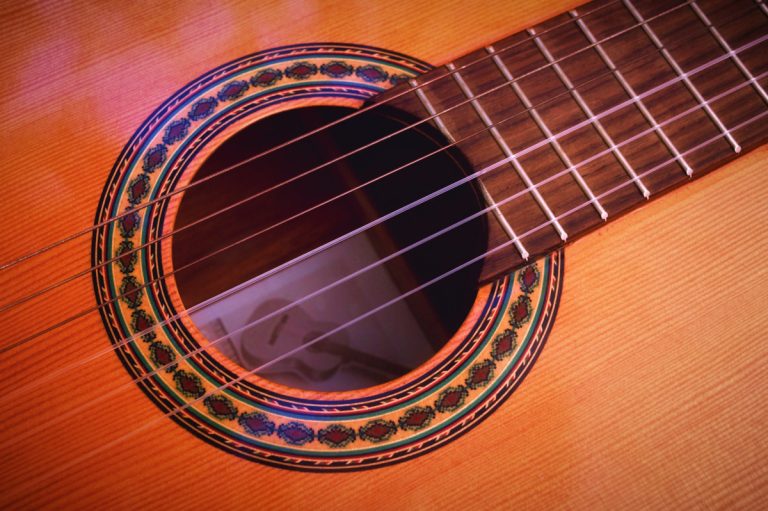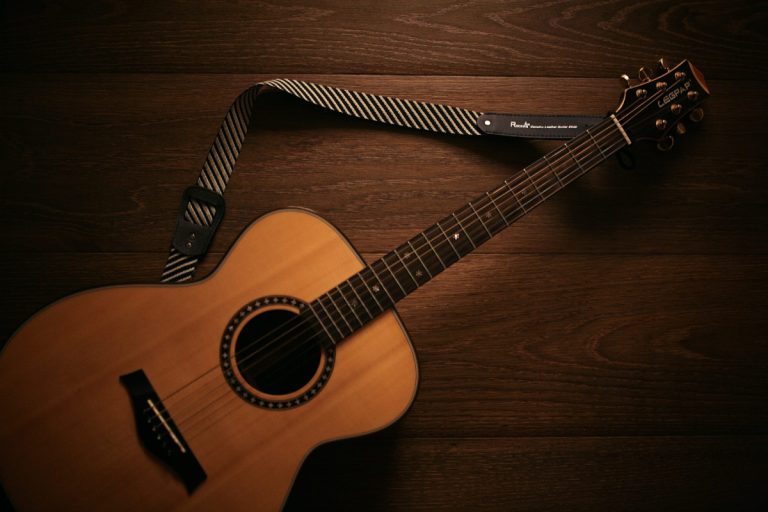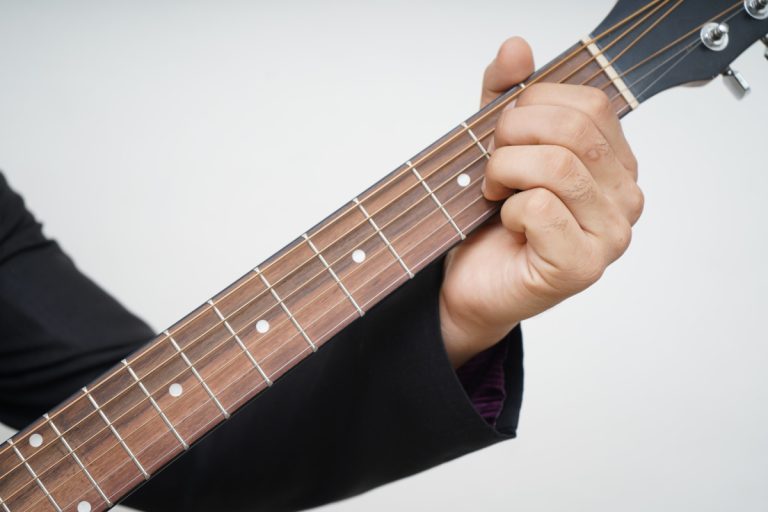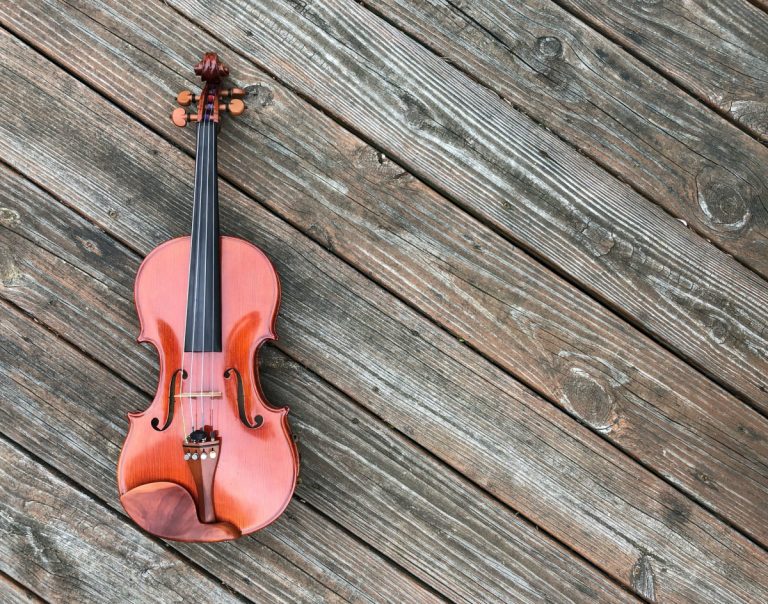Have you ever listened to a fingerstyle guitar performance and wondered what kind of guitar they played? The delicate, intricate picking patterns that define this style require an instrument that produces a clear and warm tone.
Whether you are a beginner or an experienced fingerstyle player, choosing the right guitar is essential to achieve the desired sound and playability.
This article will examine the best guitars for fingerstyle and what factors you should consider when selecting.
What’s the Difference Between Fingerstyle and Fingerpicking?
You may have encountered “fingerstyle” and “fingerpicking” interchangeably as a guitar enthusiast. While both techniques involve plucking the strings with your fingers rather than a pick, subtle distinctions between the two are worth exploring.
Fingerstyle
Fingerstyle is a percussive playing style involving various parts of the hand to create different sounds and rhythms. The thumb plucks or slaps the bass note while the other fingers pick or strum the melody.
The fingers, knuckles, nails, and finger joints can all be used to create a beat on the guitar body, making it a more complex and layered style of playing. Fingerstyle can be seen as a performance often used by solo guitarists and may not be suitable for casual jamming or campfire songs. Fingerstyle playing can be applied to various styles of music, from folk to classical to jazz.
Fingerstyle playing can involve melody and harmony, often requiring complex finger movements and coordination between right and left hands. Players specializing in fingerstyle guitar often use techniques such as thumb plucking, fingerpicking, and strumming to create a rich and dynamic sound.
Fingerpicking
Fingerpicking, on the other hand, is a specific technique within fingerstyle playing that involves using your fingers to pluck individual strings while your thumb plays a bassline. Fingerpicking is often associated with folk and country music but can also be used in other styles, such as blues and jazz.
With fingerpicking, the thumb typically plays the bassline while the other fingers pluck the melody and/or accompanying chords. This requires a lot of coordination between the fingers and thumb and often involves using different finger patterns and techniques to create a specific sound.
While fingerpicking is a specific technique within fingerstyle playing, it’s worth noting that not all fingerstyle playing involves fingerpicking. Fingerstyle guitarists may use a combination of styles, including fingerpicking, strumming, and other methods, to create sound.
Is It Difficult to Learn Fingerstyle Playing?
Fingerstyle guitar – the beautiful yet often intimidating way of playing the guitar. Many people assume that fingerstyle guitar is the most challenging way to play, but I have a slightly different opinion as someone who has had their fair share of experience in the realm of guitar playing.
Some would argue that picking with a guitar pick can be more challenging than fingerpicking. Why, you may ask? When you’re using a pick, you don’t have the same tactile feedback you get when using your fingers. With fingerpicking, you can feel the strings directly on your fingertips, making it easier to play smoothly and consistently.
On the other hand (no pun intended), using a pick means you have to rely solely on your visual and auditory senses to ensure you’re hitting the right strings at the right time. It can be easy to accidentally miss a string or hit the wrong note, which frustrates any musician.
But, of course, this is all subjective and depends on the individual musician’s preferences and skill level. Some may find fingerpicking more challenging because of the intricate finger movements involved, while others may struggle more with using a pick. However, in general, many guitarists believe that picking with a guitar pick requires higher skill and precision.
Are long fingernails needed for playing a fingerstyle guitar?
No, long fingernails are not necessary for playing fingerstyle guitar. Many professional players prefer using their fingertips rather than their nails when performing fingerpicking. The sound created with fingertips tends to be warmer and more expressive than that produced with long fingernails. Additionally, it can be challenging to control the strings when using long nails, making it difficult to achieve precise and accurate playing.
Therefore, whether or not you cultivate long fingernails for fingerstyle guitar playing is up to personal preference and depends on the desired sound. For most beginning players, fingertips are sufficient for producing a wide range of sounds.
However, it should be noted that some playing styles require long fingernails to produce the desired sound. For example, classical and flamenco guitarists often use long nails to achieve the characteristic tones of those genres. Thus, if you want to pursue playing one of these styles more seriously, it may be worth considering cultivating longer nails.
What to Consider Before Buying Fingerstyle Guitar
Fingerstyle guitar is a great way to bring your music to life, with intricate patterns of notes and chords that can captivate an audience. If you’re looking to play fingerstyle on an acoustic guitar, consider a few key features before making a purchase.
Whether you’re buying for the first time or just want to upgrade your existing instrument to fit this style of playing, here is what you should look for in your ideal fingerstyle guitar.
Brand
The brand of guitar you choose can significantly impact your playing experience. Some brands are known for exceptional quality, while others may not be as well-regarded. Researching and reading reviews from other players is essential to understanding which brands are worth considering.
You may also want to visit a music store and try out different brands and models to see which ones feel the most comfortable to play—some popular brands include Martin, Taylor, and Gibson. Additionally, established brands typically have a better resale value, which can be essential if you upgrade or sell your guitar.
Sound Quality
Fingerstyle guitars can produce various sounds depending on their construction and design. Some factors to consider when evaluating sound quality include the following:
- The tonewoods used in the guitar’s body.
- The size and shape of the guitar.
- The type of strings.
Some fingerstyle guitars are designed specifically for certain styles of music, such as blues, folk, or classical. Before purchasing a fingerstyle guitar, listening to audio recordings or watching video performances to understand how the guitar sounds in action can be helpful.
Budget
Like most musical instruments, fingerstyle guitars can range from affordable to extremely expensive. It’s important to set a budget before you start shopping and stick to it. Generally, higher-priced guitars have better sound quality, construction, and durability.
However, many great options are still available for those on a tighter budget. It’s crucial to balance your budget with the quality of the guitar to ensure you get the best value for your money.
Guitar Specs
Body Size
Many guitarists find that a smaller body is more comfortable to hold and play with, particularly for fingerstyle playing. This is because a smaller-bodied guitar is generally lighter and easier to hold, especially if you want to play while standing.
Furthermore, smaller-bodied guitars often come with a shorter scale length, which can make playing more accessible and more responsive to touch. This is because the strings are not stretched as tightly, which can reduce the amount of pressure needed to fret notes and make it easier to play more nuanced, intricate fingerstyle pieces.
Body Shape
Different body shapes can produce different tones.
For example, a dreadnought shape generally produces a louder and fuller sound, while a concert shape produces a more balanced and nuanced sound.
Tonewood
The choice of tonewood can affect the sound of the guitar. Some popular tonewoods for fingerstyle guitars include cedar, spruce, and mahogany.
Each wood has unique characteristics that can affect the guitar’s tone.
Electronics
If you plan on playing your fingerstyle guitar live or recording with it, you may want to consider a guitar with built-in electronics.
These allow you to plug your guitar into an amplifier or recording device.
Playability
Finally, the playability of the guitar is an important factor to consider. Ensure the guitar feels comfortable in your hands and the strings are not too high or too low.
A guitar with a wider neck can be easier for fingerstyle playing, while a narrower neck may be better for those with smaller hands. Test out different guitars in person to find the one that feels right.
What are the Best Guitars for Fingerstyle Playing?
Acoustic Guitars
Washburn Harvest D7S Acoustic, Natural
If you’re looking for a great fingerstyle guitar, the Washburn Harvest D7S Acoustic is an excellent choice. It has a stunning natural finish, and its solid mahogany construction ensures impressive sound quality. The cutaway design makes reaching higher frets and chords easy, while the quarter-sawn scalloped Sitka spruce bracing provides an even sound across all strings.
The satin mahogany neck is comfortable and easy to play, with twenty frets and dot inlays on an ovangkol fingerboard. The hardware of this acoustic guitar is also top-notch. It has chrome die-cast tuners, an ABS nut and an ovangkol bridge which helps to keep the tuning stable. It is strung with D’Addario EXP-16 light-set phosphor bronze strings for added resonance and clarity. The sound of this guitar is full and resonant, with a balanced combination of bass and treble frequencies. It is perfect for fingerstyle playing and will surely please any guitarist or singer-songwriter.
Washburn Harvest D7S Acoustic, Natural
Best Acoustic Guitar For Fingerstyle
Perfect For: Beginner To Advance
Features: 43mm nut width
Other Info: Scale: 25-1/2″
Pros:
- Narrow neck is ideal for players with small hands.
- Great sound quality and tonal range
- Elegant design and finish
- Solid wood construction produces a full and rich sound.
- Made in the USA with visually appealing cosmetics.
- Low action without buzzing makes it easier to play.
Cons:
- No cut-out for access to higher frets.
- Not suitable for heavier strumming styles
- Dreadnought’s body size may be too large for some players.
- May need to visit a guitar luthier for some setup adjustments.
- No built-in options for amplification.
- Only available for right-handed players, and the case must be purchased separately.
The TedScore: 9/10
Martin 000-28 Modern Deluxe, VTS Top
The Martin Modern Deluxe Series guitar combines vintage Martin specifications and modern features that create an authentic acoustic sound. The guitar is crafted with premium quality tonewoods, including a solid spruce VTS top and solid East Indian rosewood back and sides. The 000-28 Modern Deluxe model features a unique Liquidmetal bridge pin and a composite carbon fiber bridge plate that increase acoustic volume without adding extra weight. The guitar has a titanium two-way truss rod lighter than traditional truss rods, making the neck easy to adjust and incredibly strong.
The 000-28 Modern Deluxe has a traditional scalloped X-bracing made of VTS Adirondack spruce, renowned for its superior clarity and projection. The bracing has gone through the Vintage Tone System process, adding to the guitar’s vintage sound. The guitar’s neck has a slightly asymmetric profile inspired by an old OM-45 1930s model, creating a vintage Martin look and feel. The Vintage Deluxe neck shape is designed to maximize performance and comfort, with a thicker feel towards the top and a thinner feel towards the higher frets.
Martin 000-28 Modern Deluxe, VTS Top
Rock Your Frets: Guitar Mastery Made Easy
Perfect For: Intermediate to Advance
Features: ebony fingerboard with vintage diamond and square inlays
Other Info: 16″ Fretboard Radius
Pros:
- High-quality tonewoods provide a vibrant sound
- Vintage-inspired neck shape offers increased comfort
- Compensated bone saddle ensures accurate intonation
- Beautiful design and attention to detail
- Versatile for various playing styles and genres
- Includes Ply Hardshell case
Cons:
- High price point may not be accessible to all budgets
- Short scale length
- May be too advanced for beginners
The TedScore: 9/10
Taylor Big Baby BBTe Electro Acoustic, Walnut/Spruce
The Taylor Big Baby BBTe Electro Acoustic Guitar in Walnut/Spruce is an instrument that combines a rich, distinctive tone with dynamic and durable construction. It features a solid Sitka Spruce top with a layered Walnut body, which provides the durability and climate resilience of a layered body while delivering the impactful tone of a solid top. The more you play a solid top, the more its tone blossoms with richness and articulation, making it perfect for any style of play.
The BBTe’s solid Sitka Spruce top is renowned for its broad dynamics and strong, clear, defined tone, making it the ultimate soundboard for versatility. The layered Walnut back and sides of the guitar offer a responsive character with subtle high-end sparkle and mid-range presence. The layered construction’s climate-resilient strength makes it perfect for life on the road. The Taylor Big Baby BBTe is a genuinely distinctive guitar that combines the traditional dreadnought tone with a dynamic and responsive attitude. It is ideal for any guitarist or singer/songwriter needing a reliable and versatile instrument for almost any musical scenario.
Taylor Big Baby BBTe Electro Acoustic, Walnut/Spruce
Your Versatile Musical Companion
Perfect For: Beginner to Advance
Features: The BBTe features a die-cast tuning machine, a faux tortoiseshell pickguard, and chrome hardware.
Other Info: Two convenient rotary knobs allow you to adjust your tone easily, and a built-in chromatic tuner ensures you’ll always be pitch-perfect with the Big Baby.
Pros:
- Solid Sitka spruce top offers a rich and versatile tone
- Layered walnut back and sides provide durability and climate resilience
- Responsive character with subtle high-end sparkle and mid-range presence
- Liquid smooth playability with a player-friendly feel
- ES-B electronics system delivers a natural tone that stays true to the guitar’s acoustic sound
Cons:
- Layered tonewoods don’t offer the same tonal complexity as solid timbers
- The sound projection may not be as strong when flat-picked as other guitars.
- The guitar may have a slightly lower volume and less bass due to the absence of a one-piece neck.
The TedScore: 8/10
Electric Guitars
Fender Player Telecaster PF, Polar White & Case, Tweed
The Fender Player Telecaster PF in Polar White is a versatile electric guitar that delivers a classic, punchy tone with a vintage character. Equipped with premium quality electronics, including Alnico 5 single-coil pickups and a simple 3-way selector, this guitar easily shapes your sound.
Its lightweight alder body, maple neck, and pau ferro fingerboard provide a comfortable and fluid playing experience, while the vintage strings-through-body bridge ensures perfect intonation and excellent sustain. The guitar comes with a 3-ply parchment pickguard and an Electric Guitar Case by Gear4music, providing protection and comfort for your instrument on the road.
Fender Player Telecaster PF, Polar White & Case, Tweed
Upgrade Your Sound with the Fender Player Telecaster in Polar White
Perfect For: Intermediate to Advance
Features: Fingerboard Radius: 9.5″
Other Info: .009-.042 Gauges
Pros:
- Vintage-style strings-through-body bridge with block steel saddles provides excellent sustain and intonation.
- Versatile sound that suits a wide range of genres and playing styles.
- Reliable hardware and electronics for consistent performance.
- Comfortable and easy to play for extended periods.
- Attractive and classic design that will never go out of style.
- Comes with a high-quality case for easy transportation and storage.
Cons:
- Some players may prefer more advanced electronics, such as coil-splitting or active pickups.
- The glossy finish may show scratches and wear more quickly than a matte finish.
The TedScore: 8/10
Gretsch G2420T Streamliner Hollow Body, Riviera Blue
If you’re looking for a fingerstyle electric guitar that can handle any style of music, look no further than the Gretsch G2420T Streamliner Hollow Body in Riviera Blue. With its specially designed Broad’Tron BT-2S humbuckers, this guitar delivers a wide-ranging tone covering everything from scintillating highs to bellowing lows and everything in between.
The G2420T’s hollow body construction adds a booming natural resonance to your playing. At the same time, the enlarged “F”-shaped sound holes allow for more excellent acoustic projection, ensuring that every note gets heard. And with its thin “U”-shaped neck and slick gloss urethane finish, this guitar is designed for perfect playability, even during extended playing sessions.
Gretsch G2420T Streamliner Hollow Body, Riviera Blue
Get Big Tone with the Gretsch G2420T Streamliner Hollow Body
Perfect For: Intermediate to Advance
Features: Nickel-plated steel string gauges: .010 – .046
Other Info: Left Handers: No
Pros:
- Versatile and wide-ranging tone
- Booming natural resonance thanks to hollow body construction
- Effortless playing experience with thin “U”-shaped neck and slick gloss urethane finish
- Iconic Bigsby tremolo tailpiece for classic effects
Cons:
- Some players may find the high output of the Broad’Tron pickups to be too aggressive for their taste.
- Nut corners are sharp and may cause discomfort while playing.
- High-output pickups may not be suitable for those who prefer a more traditional sound.
The TedScore: 8/10
Squier Classic Vibe 60s Stratocaster Left Handed
Step back to the ’60s with the Squier Classic Vibe 60s Stratocaster Left-Handed guitar. This guitar delivers the iconic sound of the era with its powerful alnico single-coil pickups and 5-way switching system, allowing you to find the perfect pickup combination for your playing style.
The smooth and comfortable “C”-shaped neck, narrow-tall frets, and Indian laurel tonewood fingerboard make for effortless playing and fluid string bending. The vintage synchronized tremolo bridge adds a distinctive edge to your lead playing. This guitar is the perfect fit for any fingerstyle enthusiast looking to capture the timeless sound of the ’60s.
Squier Classic Vibe 60s Stratocaster Left-Handed, 3-Tone Sunburst
Vintage Tone, Modern Playability
Perfect For: Beginner to Advance
Features: Crafted with a Nato body and Maple’s neck, this left-handed guitar has a vintage-style 3-tone sunburst finish.
Other Info: Fret Size: Narrow Tall
Pros:
- Vintage 60s aesthetic and playability
- Narrow tall frets for easy string bending
- Authentic vintage synchronized tremolo bridge
- Stable tuning machines
- Fingerboard is smooth and comfortable to play on
Cons:
- Gloss finish on the neck may feel sticky and uncomfortable for some players
- Weighty 10lb body can take its toll over long periods of playing
- Neck profile might not suit all players
The TedScore: 8/10
Classical Guitars
Taylor Academy 12e-N Grand Concert Electro Classical Guitar
The Taylor Academy 12e-N is a stunning electro-classical guitar with exceptional playability and sound quality. The grand concert body design provides a comfortable playing experience and produces mesmerizing tones with its tapered waist, shorter scaler, and lighter string tension. The Lutz spruce top and layered Sapele back and sides deliver a beautifully balanced sound with superb volume, richness, and tonal warmth.
The ebony fretboard is incredibly smooth and responsive, offering bright sound and a crisp attack. The ES-B preamp on the guitar’s side discreetly allows for easy sound sculpting and amplification, with a built-in chromatic tuner ensuring pristine tuning and sonic excellence. With its exquisite design and outstanding specifications, the Taylor Academy 12e-N is the perfect choice for studio and stage fingerstyle performances. It also comes with a gig bag for easy transportation and storage.
Taylor Academy 12e-N Grand Concert Electro Classical Guitar
Best Nylon String Guitar for Fingerstyle Players
Perfect For: Intermediate and advanced fingerstyle players
Features: Tusq nut and printed headstock overlay.
Other Info: 17 frets on the fingerboard and 4mm dot Italian Acrylic inlay.
Pros:
- Beautifully balanced sound with depth and top-end sparkle
- Ebony fretboard with a lusciously smooth finish for flawless fretting
- ES-B preamp for sparkling precision and response to every touch of acoustic goodness
- Provides great sound quality
- Comfortable to play
- High-quality construction and materials
- Comes in a Gig Bag for easy portability
Cons:
- Price point may be higher than some intermediate players’ budgets
- May require periodic maintenance and adjustments to keep it in top condition
- Sometimes can be hard to tune
- Lack of a cutaway may make it challenging to access the upper frets.
The TedScore: 9/10
Takamine P3FCN FCN Nylon Electro Acoustic, Natural
The Takamine P3FCN FCN Nylon Electro Acoustic guitar is the perfect choice for fingerstyle players who want to achieve a diamond-studded sound. With a solid cedar top and sapele back and sides, this guitar produces a rich and balanced tone that is warm and articulate. The Scalloped X bracing and Concentric Rings rosette further enhance the tonal quality, while the wood dot-in-dot position inlays on the rosewood fingerboard provide excellent playability.
Equipped with Takamine’s CT4B-II preamp system, this guitar allows you to tailor your tone with a 3-band EQ and volume control, while the built-in tuner ensures that you can tune up quickly and easily. The gold hardware and split bone saddle with a pinless base provide excellent tuning stability, while the gold die-cast tuning machines with amber buttons add a touch of class. Overall, the Takamine P3FCN FCN Nylon Electro Acoustic guitar is a superb instrument that delivers the ultimate acoustic tone for fingerstyle players who demand the best.
Takamine P3FCN FCN Nylon Electro Acoustic, Natural
Get the Perfect Sound with a Takamine P3FCN
Perfect For: Intermediate to Expert Fingerstyle Guitarists
Features: Fingerboard Radius: 12″
Other Info: Feature D’Addario EJ30 Classical Nylon Strings of .028-.043 Gauges
Pros:
- Premium quality tonal capabilities
- Rich, balanced, warm and articulate sound
- Excellent playability and tuning stability
- Tailor your tone to your exact preferences with the CT4B-II preamp system
Cons:
- Higher price point may not be suitable for beginners on a tight budget
- Nylon strings may not be ideal for players who prefer the feel of steel strings
- Slightly wider nut width may not be comfortable for players with smaller hands
The TedScore: 8/10
Yamaha SLG200S Steel String Silent Guitar, Natural
Experience the best of both worlds with the Yamaha SLG200S Steel String Silent Guitar. Its thin bouts provide the ease and comfort of an electric guitar while delivering the pure tonality of a bright acoustic. The innovative SRT pickup system lets you blend piezo and microphone sounds, with built-in reverb and chorus effects, for a unique performance. You can enjoy studio-level quality straight from your headphones or amplifier.
The rosewood fingerboard allows for smooth, swift action and easy navigation of chords and melodies. It is complemented by a mahogany neck that stabilizes fingering complex chords. The Satin finish makes position changes quick and effortless.
Yamaha SLG200S Steel String Silent Guitar, Natural
Plug in your headphones or amplifier and enjoy the studio-level quality sound with Yamaha SLG200S Guitar
Perfect For: Intermediate to Advanced Guitarists
Features: 50mm – 60mm Fingerboard width
Other Info: Come with stereo earphones and 2 x AA Batteries
Pros:
- Beautiful playing experience with superb sound when amplified.
- Clever electronics with easy-to-use controls.
- Unique, lightweight, and portable design.
- Neck profile mimics a premium guitar for comfortable playing.
- 80% quieter than traditional acoustic guitars.
- Detachable frame for easy transport.
Cons:
- Divisive looks may not appeal to everyone.
- Weirdly placed guitar input may be inconvenient for some.
- Frame may become loose over time.
- Pricey compared to other acoustic guitars.
- Needs frequent tuning.
The TedScore: 8/10
Summary – Best Guitars for Fingerstyle
Selecting the best guitar for fingerstyle playing depends on various factors such as personal preferences, budget, and skill level. However, some outstanding market options cater to fingerstyle guitarists’ needs. Some of the top choices include Taylor 12e-N, Martin D-28, Gretsch G2420T, and Yamaha SLG200S. These guitars have unique tonal characteristics, playability, and design features that make them suitable for fingerstyle playing.
But what do you think? Have you tried any of these guitars for fingerstyle playing? Do you have a personal favourite that wasn’t mentioned here? We would love your opinions and experiences in the comments section below.
Remember, the most critical factor is finding a guitar that feels and sounds right for you, so feel free to try different options until you find the perfect fit.
FAQ’s
What size guitar is best for fingerpicking?
The best size guitar for fingerpicking depends on the player’s preferences and skill level. Beginner players may find starting with a 3/4-size guitar more manageable, while more experienced players may prefer a full-size instrument. Parlor-sized guitars and travel instruments can also be great options for fingerpicking. It’s important to keep in mind that any steel-string or nylon-string acoustic guitar can be used for fingerpicking. It’s ultimately up to the player to find the most comfortable size and instrument for their particular playing style.
What is the best guitar for beginners fingerstyle?
The best guitar for beginners’ fingerstyle is the Washburn Harvest D7S Acoustic, Natural. It features a solid Sitka spruce top and mahogany back and sides, providing excellent projection with an even balance of bass and treble frequencies. Its slim neck profile is ideal for fingerstyle playing, while its ovangkol fretboard provides comfortable playability. This guitar comes with D’Addario EXP-16 Light Phosphor Bronze strings, designed to bring out the best in your playing.
What makes a guitar good for fingerpicking?
A guitar good for fingerpicking should have a slim neck profile and low action to make it easier to play. It should also have a comfortable body shape and high-quality pickups explicitly designed for fingerstyle playing. The tonewoods used in the guitar’s construction will determine its sound, so look for guitars made with solid woods like mahogany, spruce, and cedar. Different strings are also necessary depending on the type of music you’re playing. To get the most out of your fingerstyle guitar, experiment with different string gauges and materials until you find the best combination.
Is classical guitar better for fingerstyle?
Classical guitar is generally considered better for fingerstyle playing due to its wider neck, lower action, and nylon strings, which are easier on the fingers and allow for a wider range of tonal possibilities.
What are the best strings for fingerstyle guitar?
The best strings for fingerstyle guitar depend on individual preference and the type of sound desired. For a bright tone, many guitarists opt for Elixir Nanoweb strings, while others may prefer the warm sound of Martin Retro MM13 or Earthwood strings. D’Addario XT 80/20 and Godin Acoustic Strings are popular among fingerstyle players.
What are the best resources to learn fingerstyle guitar?
Various resources are available for learning fingerstyle guitar, from online courses to tutorials and instructional books. Popular online sources include TrueFire and JustinGuitar, while books like “Fingerstyle Guitar: The Complete Fingerstyle Guitar Method” by Steve Eckels provide a comprehensive overview of the genre. It’s important to find resources that fit your style and skill level. Additionally, taking lessons from a qualified instructor will ensure you learn the proper techniques for fingerstyle guitar.
How to hold a guitar while fingerpicking?
If you want to play fingerstyle guitar, your body must be in the correct position. To get comfortable and make sure you have a great sound, follow these tips when positioning yourself and your acoustic guitar for fingerpicking:
Holding The Guitar – Make sure the guitar neck is centred on your chest and the guitar body rests against your stomach. Your right arm should be curved, with your wrist resting on the top of the guitar’s lower bout (side). This will ensure that you can move it freely while playing.
Arm Position – Keep your left arm perpendicular to the neck, close enough so your fingers can reach the strings without straining. Keep your elbow close to the body, and keep your wrist straight. This makes it easier to move your fingers freely while playing.
When you’re comfortable with these steps, it’s time to find the right fingerstyle acoustic guitar for you! It’s important to find one that fits your style of music as well as your skill level. Look for the best acoustic guitars that offer features like a solid top, matte finish, and custom bracing to get the sound you want.
What makes a good acoustic guitar for fingerstyle?
An excellent acoustic guitar for fingerstyle should have wide string spacing and a neck width that are comfortable to play. Additionally, the guitar’s body shape should be chosen carefully; it should be selected to enhance the tone of picked notes and bring out their timbre. When picking an acoustic guitar for fingerstyle, it’s essential to consider all these factors to ensure a great playing experience. Researching and trying out different guitars can help you find the best fingerstyle guitars that suit your needs.
